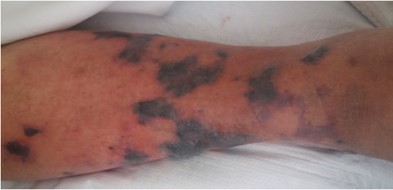Case Presentation: A 69-year old male with past medical history significant for granulomatosis with polyangiitis and lower extremity deep vein thrombosis (DVT) presented with worsening pain, swelling and erythema of his right lower extremity. He reported exposure to stagnant rainwater in his yard a day prior to admission. Hours after the exposure he developed fever up to 102 F and he noticed the appearance of black blisters. List of medications included prednisone and mycophenolate for his vasculitis, and rivaroxaban for history of DVT. His initial vital signs were within normal limits. His physical exam was remarkable for non-pitting edema, erythema and confluent black bullae on his right lower extremity. Pertinent laboratory tests included left shift leukocytosis of 27.4 k/uL, hyponatremia of 132 mEq/L, lactic acidosis of 6.6 mmol/L, erythrocyte sedimentation rate of 17 mm/hr and C-reactive protein of 28.9 mg/L. Given his immunocompromised state, physical exam findings and laboratory abnormalities, an urgent consult to general surgery service was placed, as there was high concern for necrotizing fasciitis. He was started on broad spectrum antibiotics with Meropenem, Vancomycin and Clindamycin and scheduled for urgent decompression fasciotomy. While waiting for the surgery he underwent CT scan without contrast of his right leg which showed prominent subcutaneous edema with associated fat stranding circumferentially with no fascial or soft tissue air foci or drainable collections. His lower extremity doppler was negative for DVT. He underwent intraoperative debridement, and his intraoperative cultures grew Aeromonas veronii, susceptible to Levofloxacin. His antibiotics were de-escalated, and he recovered favorably.
Discussion: Aeromonas are rod-shaped, Gram negative bacteria that are ubiquitous inhabitants of fresh and brackish water. Infection by Aeromonas species usually presents as gastroenteritis or water/soil traumatic wound infections. They have the potential to cause severe cellulitis and sepsis in immunocompromised individuals. These infections could present as rapidly progressive cellulitis and can require surgical debridement and, in rare cases, amputation. Outbreaks are usually reported in areas with warm and humid climate. It is important to consider these pathogens as a potential cause of infection in patients who present with cellulitis, particularly in immunocompromised patients, as Aeromonas spp can produce beta-lactamases that include classes A-D, and in some cases, harbor ESBL, AmpC or carbapenemases. Empiric treatment with non-beta lactam antibiotics such as fluoroquinolones should be started while waiting for cultures and susceptibilities.
Conclusions: Skin and soft tissue infection by Aeromonas species should be strongly considered in immunocompromised patients with history of exposure to brackish water, as it can rapidly evolve and cause necrotizing fasciitis. Adequate empiric antibiotic coverage with either fluoroquinolones, sulfonamides, or carbapenem should be started without delay.

